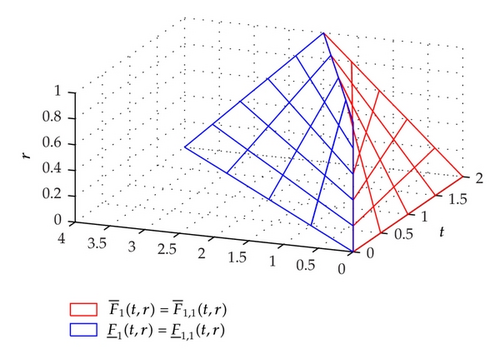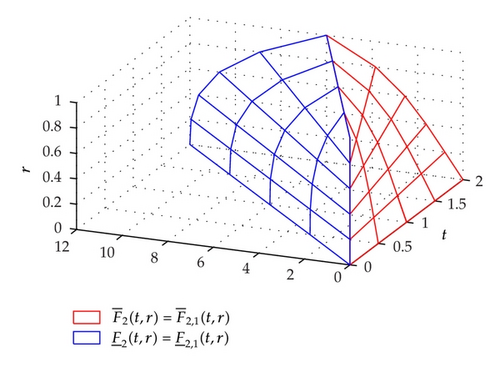A Numerical Scheme to Solve Fuzzy Linear Volterra Integral Equations System
Abstract
The current research attempts to offer a new method for solving fuzzy linear Volterra integral equations system. This method converts the given fuzzy system into a linear system in crisp case by using the Taylor expansion method. Now the solution of this system yields the unknown Taylor coefficients of the solution functions. The proposed method is illustrated by an example and also results are compared with the exact solution by using computer simulations.
1. Introduction
Many mathematical formulations of physical phenomena contain integral equations. These equations appear in physics, biological models, and engineering. Since these equations are usually difficult to solve explicitly, so it is required to obtain approximate solutions. In recent years, numerous methods have been proposed for solving integral equations. For example, Tricomi, in his book [1], introduced the classical method of successive approximations for nonlinear integral equations. Variational iteration method [2] and Adomian decomposition method [3] were effective and convenient for solving integral equations. Also the Homotopy analysis method (HAM) was proposed by Liao [4] and then has been applied in [5]. Moreover, some different valid methods for solving this kind of equations have been developed. First time, Taylor’s expansion approach was presented for solution of integral equations by Kanwal and Liu in [6] and then has been extended in [7–9]. In addition, Babolian et al. [10] by using the orthogonal triangular basis functions solved some integral equation systems. Jafari et al. [11] applied Legendre’s wavelets method to find numerical solution system of linear integral equations. Also Sorkun and Yalçinbaş [12] approximated a solution of linear Volterra integral equations system with the help of Taylor’s series.
In this paper, we want to propose a new numerical approach to approximate the solution of a fuzzy linear Volterra integral equations system. This method converts the given fuzzy system that supposedly has a unique fuzzy solution, into crisp linear system. For this scope, first, the Taylor expansions of unknown functions are substituted in parametric form of the given fuzzy system. Then we differentiate both sides of the resulting integral equations of the system N times and also approximate the Taylor expansion by a suitable truncation limit. This work yields a linear system in crisp case, so the solution of the linear system yields the unknown Taylor coefficients of the solution functions. An interesting feature of this method is that we can get an approximate of the Taylor expansion in arbitrary point to any desired degree of accuracy. Here is an outline of the paper. In Section 2, the basic notations and definitions of the integral equation and the Taylor polynomial method are briefly presented. Section 3 describes how to find an approximate solution of the given fuzzy Volterra integral equations system with using proposed approach. Finally in Section 4, we apply the proposed method by an example to show the simplicity and efficiency of the method.
2. Preliminaries
In this section, the most basic used notations in fuzzy calculus and integral equations are briefly introduced. We started by defining the fuzzy number.
Definition 2.1. A fuzzy number is a fuzzy set u : ℝ1 → I = [0,1] such that
- (i)
u is upper semicontinuous,
- (ii)
u(x) = 0 outside some interval [a, d],
- (iii)
there are real numbers b, c : a ≤ b ≤ c ≤ d, for which:
- (1)
u(x) is monotonically increasing on [a, b],
- (2)
u(x) is monotonically decreasing on [c, d],
- (3)
u(x) = 1, b ≤ x ≤ c.
- (1)
Definition 2.2. A fuzzy number v is a pair of functions and , which satisfy the following requirements:
- (i)
is a bounded monotonically increasing left continuous function on (0,1] and right continuous at 0,
- (ii)
is a bounded monotonically decreasing left continuous function on (0,1] and right continuous at 0,
- (iii)
.
2.1. Operation on Fuzzy Numbers
Definition 2.3. For arbitrary fuzzy numbers u, vϵE1 the quantity
Definition 2.4. Let f : [a, b] → E1. For each partition P = {t0, t1, …, tn} of [a, b] and for arbitrary ξiϵ[ti−1, ti] (1 ≤ i ≤ n), suppose
2.2. System of Integral Equations
The basic definition of integral equation is given in [21].
Definition 2.5. The Fredholm integral equation of the second kind is
Definition 2.6. The second kind fuzzy linear Volterra integral equations system is in the form
Now let and (0 ≤ r ≤ 1; a ≤ t ≤ b) be parametric form of fi(t) and Fi(t), respectively. To simplify, we assume that λij > 0 (for i, j = 1, …, m). In order to design a numerical scheme for solving (2.15), we write the parametric form of the given fuzzy integral equations system as follows:
2.3. Taylor’s Series
3. Convergence Analysis
In this section, we proved that the above numerical method converges to the exact solution of fuzzy system (2.15).
Theorem 3.1. Let the kernel be bounded and belong to L2 and and for j = 1, …, m) be Taylor polynomials of degree N that their coefficients are produced by solving the linear system (2.25). Then these polynomials converge to the exact solution of the fuzzy Volterra integral equations system (2.15), when N → +∞.
Proof. Consider the system (2.15). Since, the series (2.20) converge to and , respectively, then we conclude that
4. An Example
In this section, we present an example of fuzzy linear Volterra integral equations system and results will be compared with the exact solution.
Example 4.1. Consider the system of fuzzy linear Volterra integral equations with


5. Conclusions
Fuzzy integral equations systems, which have a very important place in physics and engineering, are usually difficult to solve analytically. Therefore, it is required to obtain approximate solutions. In this study, mechanization of solving fuzzy linear Volterra integral equations system of the second kind by using the Taylor expansion method have proposed. This Taylor method transforms the given problem to a linear algebraic system in crisp case. The solution of the resulting system is used to compute unknown Taylor coefficients of the solution functions. Consider that to get the best approximating solutions of the given fuzzy equations, the truncation limit N must be chosen large enough. An interesting feature of this method is finding the analytical solution for given fuzzy system, if the exact solution be polynomials of degree N or less than N. The results of the example indicate the ability and reliability of the present method.




